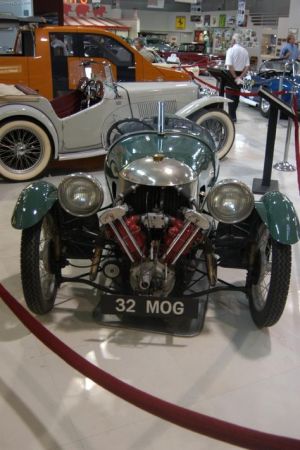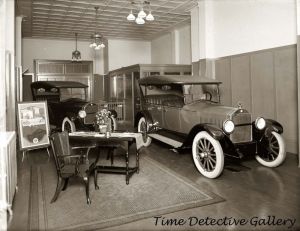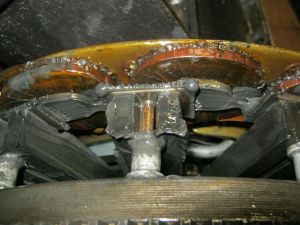- Home
- About Us
- Join/Renew
- Member Benefits
- Member Pages
- Log In
- Help
- Museum Store
Greg,
Goggles and a leather helmet are required.

Bill: Goggles, leather helmet, gloves and a scarf around your neck, to pull up over your mouth so you don’t inhale the droplets of oil.
You do know that the WWI aircraft engines usually used a caster-oil based engine lubricant? It has better high temperature qualities than petroleum oils.. Castrol still makes a vegetable oil based engine oil.
But, the side effect was that the pilots breathed in the oil mist, droplets and crankcase fumes from the Castor-oil based engine oil.. And.. the laxative effect of the Castor Oil was a real problem for the pilots..
The scarf that is such a ‘symbol’ of the WWI pilot was used to breath through, to reduce the dose of Castor Oil you inhaled or swallowed on each flight.
So, I assume you did not use Vegetable oil based engine oil in your Morgan 3-wheeler?
Greg Long
Greg,
You never cease to amaze me with your in-depth knowledge of obscure but important, particularly in the day, facts. I was more worried about my teeth falling out or getting run over. I guess the scarf could be dual purpose?
Bill
About 15 years ago I dropped off the engine from a Ford Model T to a highly recommended local builder for a complete rebuild. After 2 months it was done and I installed it in the car. While setting it up I pulled the plugs to check the gap. Looked down the plug holes and saw cardboard. Removed the head and there was a piece of cardboard in each cylinder in the shape of the combustion chamber. The builder had placed them for when he sprayed the copper coating on the head gasket but forgot to remove after. Needless to say I tore apart the entire engine for an inspection. I was less than impressed with the entire build and had most of it redone.
Never ceases to amaze me how some people can have such a good reputation when their work is questionable at best.
Jim, that would not have been good for the pistons to have cardboard on them during startup.
Sometimes people don’t live up to the hype.
Attached picture has a caption that says it is a Scripps-Booth Showroom.

Hoo boy. . .
Ever hear of a product called “Time Saver”?
This is allegedly for fitting main and rod bearings if you don’t have the patience to scrape in thick babbitt, like when you don’t grind the crankshaft journals.
I had a 1912 Model T several years ago, the engine of which I took to a Boston-area re-builder who seemed to be reputable. Got the engine back, and with just one trip around the block heard quite a severe knocking in the engine. Finally I pulled the engine and took it all apart. The photo is what I found.
The guy used this “Time Saver” lapping compound to fit the bearings but never removed it. He left it in there as a thick, gritty, goo like toothpaste. So when I ran the engine, it continued to lap away at the bearings like throwing a handful of sand into the crankcase. In this case, it wore away the third main which, in a Model T, sets the longitudinal clearance of the crankshaft, so the magnets were hitting the field coils.
I was really pissed and posted the photos all over the Model T forum.
Come to find out, he screwed several people.
He’s no longer in business.
I do all of my own work now unless I really know the guy I farm stuff out to.
— Luke

The oil spray produced at the WWI rotary engines would fog up the googles of the pilots. The scarf was used to clean the lenses.
Luke, I remember all that back when it was happening, a sad thing. On the other side, I’ve used Time Saver in every one of my T’s over the years as a final burnish and if done right is really good stuff, Gen3 (his name was Tim) was third generation in the hobby but unlike his Grandfather who was a positive influence when I was 13, his father who was one of the nicest people you could find in the hobby and knew my dad fairly well, and his brother Matt who I’ve been on tours with several times and would go out of my way to help and he would be the same whether you knew him or not, Tim was nothing more than something you can think but not write on a civilized forum! I made the mistake of getting him together with a friend in Maine who was getting too old to take care of his 26 Fordor, sadly Tim puts in a homemade overhead which never ran right, burned out the bottom end and then badmouths the last owner. I had been on at least 10 tours with Bill and his car, it was not perfect but ran good. Many people in that area, myself included, couldn’t stand him and would leave when he walked over to a conversation. I can get along with just about anyone who is into old cars, but not Tim…
I saw myself a Series 80 reproduction aluminum head which had only one of the coolant holes drilled; overheating was the symptom which led to this discovery. It was from a reputable supplier and was installed by a reputable rebuilder.
